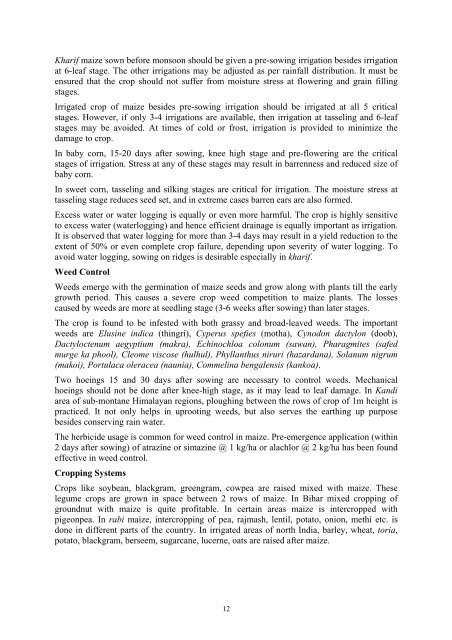You also want an ePaper? Increase the reach of your titles
YUMPU automatically turns print PDFs into web optimized ePapers that Google loves.
Kharif <strong>maize</strong> sown before monsoon should be given a pre-sowing irrigation besides irrigation<br />
at 6-leaf stage. The other irrigations may be adjusted as per rainfall distribution. It must be<br />
ensured that the crop should not suffer from moisture stress at flowering and grain filling<br />
stages.<br />
Irrigated crop of <strong>maize</strong> besides pre-sowing irrigation should be irrigated at all 5 critical<br />
stages. However, if only 3-4 irrigations are available, then irrigation at tasseling and 6-leaf<br />
stages may be avoided. At times of cold or frost, irrigation is provided to minimize the<br />
damage to crop.<br />
In baby corn, 15-20 days after sowing, knee high stage and pre-flowering are the critical<br />
stages of irrigation. Stress at any of these stages may result in barrenness and reduced size of<br />
baby corn.<br />
In sweet corn, tasseling and silking stages are critical for irrigation. The moisture stress at<br />
tasseling stage reduces seed set, and in extreme cases barren ears are also formed.<br />
Excess water or water logging is equally or even more harmful. The crop is highly sensitive<br />
to excess water (waterlogging) and hence efficient drainage is equally important as irrigation.<br />
It is observed that water logging for more than 3-4 days may result in a yield reduction to the<br />
extent of 50% or even complete crop failure, depending upon severity of water logging. To<br />
avoid water logging, sowing on ridges is desirable especially in <strong>kharif</strong>.<br />
Weed Control<br />
Weeds emerge with the germination of <strong>maize</strong> seeds and grow along with plants till the early<br />
growth period. This causes a severe crop weed competition to <strong>maize</strong> plants. The losses<br />
caused by weeds are more at seedling stage (3-6 weeks after sowing) than later stages.<br />
The crop is found to be infested with both grassy and broad-leaved weeds. The important<br />
weeds are Elusine indica (thingri), Cyperus spefies (motha), Cynodon dactylon (doob),<br />
Dactyloctenum aegyptium (makra), Echinochloa colonum (sawan), Pharagmites (safed<br />
murge ka phool), Cleome viscose (hulhul), Phyllanthus niruri (hazardana), Solanum nigrum<br />
(makoi), Portulaca oleracea (naunia), Commelina bengalensis (kankoa).<br />
Two hoeings 15 and 30 days after sowing are necessary to control weeds. Mechanical<br />
hoeings should not be done after knee-high stage, as it may lead to leaf damage. In Kandi<br />
area of sub-montane Himalayan regions, ploughing between the rows of crop of 1m height is<br />
practiced. It not only helps in uprooting weeds, but also serves the earthing up purpose<br />
besides conserving rain water.<br />
The herbicide usage is common for weed control in <strong>maize</strong>. Pre-emergence application (within<br />
2 days after sowing) of atrazine or simazine @ 1 kg/ha or alachlor @ 2 kg/ha has been found<br />
effective in weed control.<br />
Cropping Systems<br />
Crops like soybean, blackgram, greengram, cowpea are raised mixed with <strong>maize</strong>. These<br />
legume <strong>crops</strong> are grown in space between 2 rows of <strong>maize</strong>. In Bihar mixed cropping of<br />
groundnut with <strong>maize</strong> is quite profitable. In certain areas <strong>maize</strong> is intercropped with<br />
pigeonpea. In rabi <strong>maize</strong>, intercropping of pea, rajmash, lentil, potato, onion, methi etc. is<br />
done in different parts of the country. In irrigated areas of north India, barley, wheat, toria,<br />
potato, blackgram, berseem, sugarcane, lucerne, oats are raised after <strong>maize</strong>.<br />
12

















